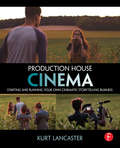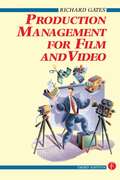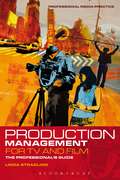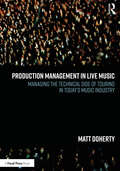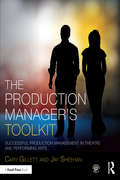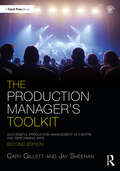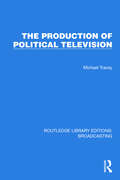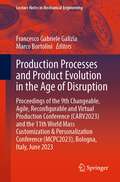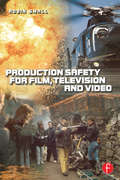- Table View
- List View
Production House Cinema: Starting and Running Your Own Cinematic Storytelling Business
by Kurt LancasterIn Production House Cinema: Starting and Running Your Own Cinematic Storytelling Business, renowned video storyteller Kurt Lancaster offers both students and professionals a practical guide to starting their own video production company and creating cinematic, client-based video content. Utilizing practical know-how along with in-depth analysis and interviews with successful independent production houses like Stillmotion and Zandrak, Lancaster follows the logistics and inspiration of creating production house cinema from the initial client pitch all the way through financing and distribution. The book includes: An examination of the cinematic and narrative style and how to create it; A discussion of the legal procedures and documents necessary for starting and operating a production house; Advice on crafting a portfolio, reel, and website that both demonstrates your unique style and vision and attracts clients; A guide to the financial business of running an independent production house, including invoicing, accounting, and taxes—and how much you should charge clients; Tips for how to better communicate with clients, and how to develop and shape a client’s story; A breakdown of how to select the right gear and equipment for a shoot, on budget; Cinematic case studies that offer detailed coverage of several short films made for clients.
Production Management for Film and Video
by Richard GatesPacked with step by step information, hints and tips, this book provides all the basic information needed to production manage a film or video from beginning to end - from idea to delivery. Production Management for Film and Video gives all the basic information needed to production manage a film or video from beginning to end - from idea to delivery.Aspiring young film producers, programme makers and students of film or video production will find this an essential source of information, as indeed will anybody wishing to improve their knowledge and skills in the field. One is guided from the script or proposal, right through the various stages of production management to include:· script breakdown· crossplotting· scheduling· budgeting· preparation· the shoot· editing and post-production· deliveryNow in its third edition, Production Management for Film and Video has been further revised to include: · information on health and safety requirements· the need to be aware of computer generated imagery · the effect this kind of programme making has on schedules and budgets. Different kinds of management for different productions are also covered - from features through to documentaries - and advice is offered on how to run a production more effectively. Examples, taken from actual productions, demonstrate the kind of documentation needed to develop, run and control a production. Emphasis is placed on the basic principles of good management that apply to all the different kinds of film that can be produced.Richard Gates is a freelance producer/production manager and has been involved in over 40 productions of different kinds. He also lectures extensively on production and production management techniques.
Production Management for Film and Video
by Richard GatesPacked with step by step information, hints and tips, this book provides all the basic information needed to production manage a film or video from beginning to end - from idea to delivery. Production Management for Film and Video gives all the basic information needed to production manage a film or video from beginning to end - from idea to delivery.Aspiring young film producers, programme makers and students of film or video production will find this an essential source of information, as indeed will anybody wishing to improve their knowledge and skills in the field. One is guided from the script or proposal, right through the various stages of production management to include:· script breakdown· crossplotting· scheduling· budgeting· preparation· the shoot· editing and post-production· deliveryNow in its third edition, Production Management for Film and Video has been further revised to include: · information on health and safety requirements· the need to be aware of computer generated imagery · the effect this kind of programme making has on schedules and budgets. Different kinds of management for different productions are also covered - from features through to documentaries - and advice is offered on how to run a production more effectively. Examples, taken from actual productions, demonstrate the kind of documentation needed to develop, run and control a production. Emphasis is placed on the basic principles of good management that apply to all the different kinds of film that can be produced.Richard Gates is a freelance producer/production manager and has been involved in over 40 productions of different kinds. He also lectures extensively on production and production management techniques.
Production Management for TV and Film: The professional's guide (Professional Media Practice)
by Linda Stradling"What Linda Stradling doesn't know about production management isn't worth knowing" The Documentary Filmmakers GroupPlaying a key role in helping producers to interpret and realise the directors' vision, production managers are responsible for all organisational aspects of TV and film production - from start to finish. Now this essential handbook tells you how it's done. Written by highly experienced production manager and specialist tutor, Linda Stradling, this is a complete guide to the profession. It includes details on self-organisation and the best systems to use, budgets, schedules and cost control, hiring and firing, contracts, insurance, setting up a shoot, dealing with contributors, acquiring copyright, people skills and ethics. So whether you're just starting out or want to improve your knowledge and skills, this is the book for you.
Production Management for TV and Film: The professional's guide (Professional Media Practice)
by Linda Stradling"What Linda Stradling doesn't know about production management isn't worth knowing" The Documentary Filmmakers GroupProduction Managers are responsible for all the organisational aspects of a TV or film production such as scheduling and budgeting and assisting producers to interpret and realise the directors' vision. Linda Stradling is a highly experienced production manager and trainer. Her book is based on her training handouts and notes and offers a complete `manual' to the role including: self organisation and systems to use, budgets, schedules and cost control, cash flow, hiring and firing, contracts, insurance, health and safety, setting up an efficient and cost-effective shoot, dealing with contributors, acquiring copyright, sourcing CGI, editors, music cue sheets, deliverables, people skills and ethics. A chapter contribution is included from leading drama production manager Julie Clark (currently line producer on Glorious 39, Stephen Poliakoff's new film). Written by an industry insider, this is an exhaustive manual to every aspect of the job, with reference material and real-life examples. Essential paperwork and sample budgets can also be found on our website. A complete on-the-job reference tool.
Production Management in Live Music: Managing the Technical Side of Touring in Today’s Music Industry
by Matt DohertyProduction Management in Live Music: Managing the Technical Side of Touring in Today’s Music Industry is a handbook for the aspiring production manager looking to forge a career in the live music industry. This book outlines the role that a production manager performs and their key responsibilities, and takes the reader step by step through the entire process of preparing a show for a tour. From dealing with artists and management to hiring crew, from booking vendors and scheduling the day-to-day of a busy tour, this text covers everything that is needed to take the show into rehearsals and finally on the road. Every aspect of the job is covered, including the very important challenges that face today’s industry in the realms of sustainability, inclusion, diversity and mental health. Whether the show be on a festival, in a small theatre or club, or in a modern arena, this book clearly lays out the tasks and challenges and offers practical solutions to ensure the smooth running of a live performance. Production Management in Live Music is written for students in stage and production management courses and emerging professionals working in live music touring.
Production Management in Live Music: Managing the Technical Side of Touring in Today’s Music Industry
by Matt DohertyProduction Management in Live Music: Managing the Technical Side of Touring in Today’s Music Industry is a handbook for the aspiring production manager looking to forge a career in the live music industry. This book outlines the role that a production manager performs and their key responsibilities, and takes the reader step by step through the entire process of preparing a show for a tour. From dealing with artists and management to hiring crew, from booking vendors and scheduling the day-to-day of a busy tour, this text covers everything that is needed to take the show into rehearsals and finally on the road. Every aspect of the job is covered, including the very important challenges that face today’s industry in the realms of sustainability, inclusion, diversity and mental health. Whether the show be on a festival, in a small theatre or club, or in a modern arena, this book clearly lays out the tasks and challenges and offers practical solutions to ensure the smooth running of a live performance. Production Management in Live Music is written for students in stage and production management courses and emerging professionals working in live music touring.
The Production Manager's Toolkit: Successful Production Management in Theatre and Performing Arts (The Focal Press Toolkit Series)
by Cary Gillett Jay Sheehan"Our theater world is so much better with this book in it, and even better with Cary and Jay at the helm." –David Stewart, Director of Production for the Guthrie Theater The Production Manager’s Toolkit is a comprehensive introduction to a career in theatrical and special event production for new and aspiring professionals, given by expert voices in the field. The book discusses management techniques, communication skills, and relationship building tactics to create effective and successful production managers. With a focus on management theory, advice from top production managers provide insights into budgeting, scheduling, meetings, hiring, maintaining safety, and more. Through interviews and case studies, the history and techniques of production management are explored throughout a variety of entertainment venues: theatre, dance, opera, and special events. The book includes references, tools, templates, and checklists; and a companion website contains downloadable paperwork and links to other useful resources such as unions, venues, and vendors.
The Production Manager's Toolkit: Successful Production Management in Theatre and Performing Arts (The Focal Press Toolkit Series)
by Cary Gillett Jay Sheehan"Our theater world is so much better with this book in it, and even better with Cary and Jay at the helm." –David Stewart, Director of Production for the Guthrie Theater The Production Manager’s Toolkit is a comprehensive introduction to a career in theatrical and special event production for new and aspiring professionals, given by expert voices in the field. The book discusses management techniques, communication skills, and relationship building tactics to create effective and successful production managers. With a focus on management theory, advice from top production managers provide insights into budgeting, scheduling, meetings, hiring, maintaining safety, and more. Through interviews and case studies, the history and techniques of production management are explored throughout a variety of entertainment venues: theatre, dance, opera, and special events. The book includes references, tools, templates, and checklists; and a companion website contains downloadable paperwork and links to other useful resources such as unions, venues, and vendors.
The Production Manager's Toolkit: Successful Production Management in Theatre and Performing Arts (The Focal Press Toolkit Series)
by Cary Gillett Jay SheehanThe Production Manager’s Toolkit Second Edition offers an up-to-date, comprehensive introduction to a theatrical and special event production career for new and aspiring professionals, given by expert voices in the field. The book discusses management techniques, communication skills, and relationship building tactics to become effective and successful production managers. With a focus on management theory, top production managers provide insights into budgeting, scheduling, meetings, hiring, maintaining safety, and more. Through interviews and case studies, production management techniques are explored throughout various entertainment genres including theatre, dance, opera, music, and special events. The second edition includes all new case studies, new chapters, and updated content throughout, showcasing a continued progressive approach to the job and the field. Filled with references, tools, templates, and checklists, The Production Manager’s Toolkit is an invaluable resource for students of Production Management, Events Management, and Stage Management courses, as well as new and aspiring professionals. The book includes access to a companion website featuring downloadable paperwork and links to other useful resources such as unions, venues, and vendors. (www.routledge.com/cw/gillett)
The Production Manager's Toolkit: Successful Production Management in Theatre and Performing Arts (The Focal Press Toolkit Series)
by Cary Gillett Jay SheehanThe Production Manager’s Toolkit Second Edition offers an up-to-date, comprehensive introduction to a theatrical and special event production career for new and aspiring professionals, given by expert voices in the field. The book discusses management techniques, communication skills, and relationship building tactics to become effective and successful production managers. With a focus on management theory, top production managers provide insights into budgeting, scheduling, meetings, hiring, maintaining safety, and more. Through interviews and case studies, production management techniques are explored throughout various entertainment genres including theatre, dance, opera, music, and special events. The second edition includes all new case studies, new chapters, and updated content throughout, showcasing a continued progressive approach to the job and the field. Filled with references, tools, templates, and checklists, The Production Manager’s Toolkit is an invaluable resource for students of Production Management, Events Management, and Stage Management courses, as well as new and aspiring professionals. The book includes access to a companion website featuring downloadable paperwork and links to other useful resources such as unions, venues, and vendors. (www.routledge.com/cw/gillett)
The Production Manual: A Graphic Design Handbook (Required Reading Range)
by Gavin Ambrose Paul HarrisFrom the basics such as working with typography through using images and working with color, exploring different pre-press techniques and the processes involved in bringing a product to press and with a resulting pleasing end product, the authors present everything that the reader needs to know in a straightforward and visually strong way. This new edition completely updates the information on the production process, highlighting new techniques and expanding its coverage on digital technologies. In addition, new interviews are included from design studios using creative or unique production techniques. Since students may eventually be working with international clients, the authors includes both metric and imperial measurements so that students will become familiar with the differences. Expanded coverage of environmental and sustainability issues, especially as they relate to paper choice and use of special processes/inks has also been added.
The Production Manual: A Graphic Design Handbook (Required Reading Range Ser.)
by Gavin Ambrose Paul HarrisFrom the basics such as working with typography through using images and working with color, exploring different pre-press techniques and the processes involved in bringing a product to press and with a resulting pleasing end product, the authors present everything that the reader needs to know in a straightforward and visually strong way. This new edition completely updates the information on the production process, highlighting new techniques and expanding its coverage on digital technologies. In addition, new interviews are included from design studios using creative or unique production techniques. Since students may eventually be working with international clients, the authors includes both metric and imperial measurements so that students will become familiar with the differences. Expanded coverage of environmental and sustainability issues, especially as they relate to paper choice and use of special processes/inks has also been added.
Production Methods: Behind the Scenes of Virtual Inhabited 3D Worlds
by Kim H. Madsen Lars QvortrupKim Halskov Madsen Up until a few decades ago, business administration and science were the primary areas in which computers were applied, but terms like pervasive computing reflect that interactive computing power is becoming an embedded part of people's every day environment, not only office buildings and private homes but also art and cul At one of the frontiers of multimedia applications computers are used as tural events. part of experimental theatre, puppet theatre, musical performances, museums, entertainment, and learning. In some of these domains, people interact with the computers using a mouse, keyboard and a 17-inch monitor, but present-day inter faces take a variety of forms, including motion-capture technology and displays of up to several metres in height and width. The trend of applying computer technologies in the domain of art and culture has been one of the pivots of a Danish research project, Staging of Virtual Inhabited 3D Spaces. The results of the project are presented in a series of four volumes, of which this book is the last one. The three other publications are: Virtual Interaction: Interaction in Virtual Inhabited 3D Worlds; Virtual Space: The Spatiality of Virtual Inhabited 3D Worlds; and 3D Applications: Applications with Virtual Inhabited 3D Worlds.
The Production of Heritage: The Politicisation of Architectural Conservation
by Alan Chandler Michela PaceIn this important book, the authors unpack the theoretical and practical issues around the development of heritage sites, critically dissecting key conservation benchmarks such as the ICOMOS guidelines, BS 7913 and the RIBA Conservation Plan of Work to reveal the mechanics of heritage guidance, its advantages and conceptual limitations. Underpinned by an active understanding of the conservation philosophy of William Morris, the book presents five case studies from the UK and North and South America that speak about different facets of heritage value, such as urban identity, commodification, authenticity, materiality and heritage as an intellectual and ethical framework. Heritage is never neutral; its definition is privileged yet its influence is political. Art, landscape and archaeology all offer examples of how the operational ideas of adjacent disciplines can influence an integrated idea of heritage conservation, and how this is communicated in order to determine significance and share in its custodianship. This book provides insights into how to identify and challenge these limitations, expanding inclusion by describing tactics for changing how people can relate to and build on the past. Clearly written for all levels of readership within the conservation professions and community custodians of heritage buildings and places, the book provides strategies and tactics for understanding the heritage significance of materials, their fabrication, detail and use. The narratives that historic fabric contains can help shape the meaningful involvement of local people, providing a roadmap for those navigating the double-bind of using the past to underpin the future.
The Production of Heritage: The Politicisation of Architectural Conservation
by Alan Chandler Michela PaceIn this important book, the authors unpack the theoretical and practical issues around the development of heritage sites, critically dissecting key conservation benchmarks such as the ICOMOS guidelines, BS 7913 and the RIBA Conservation Plan of Work to reveal the mechanics of heritage guidance, its advantages and conceptual limitations. Underpinned by an active understanding of the conservation philosophy of William Morris, the book presents five case studies from the UK and North and South America that speak about different facets of heritage value, such as urban identity, commodification, authenticity, materiality and heritage as an intellectual and ethical framework. Heritage is never neutral; its definition is privileged yet its influence is political. Art, landscape and archaeology all offer examples of how the operational ideas of adjacent disciplines can influence an integrated idea of heritage conservation, and how this is communicated in order to determine significance and share in its custodianship. This book provides insights into how to identify and challenge these limitations, expanding inclusion by describing tactics for changing how people can relate to and build on the past. Clearly written for all levels of readership within the conservation professions and community custodians of heritage buildings and places, the book provides strategies and tactics for understanding the heritage significance of materials, their fabrication, detail and use. The narratives that historic fabric contains can help shape the meaningful involvement of local people, providing a roadmap for those navigating the double-bind of using the past to underpin the future.
The Production of Hospice Space: Conceptualising the Space of Caring and Dying
by Sarah McGannChallenging the widely held notion of a hospice as a building or a place, this book argues that it should instead be a philosophy of care. It proposes that the positive and negative impact that space can have in the pursuit of an ideal such as hospice care has previously been underestimated. Whether it be a purpose-built hospice, part of a hospital, a nursing home or within the home, a hospice is anchored by space and spatial practices, and these spatial practices are critical for a holistic approach to dying with dignity. Such spatial practices are understood as part of a broad architectural, social, conceptual and theoretical process. By linking health, social and architectural theory and establishing conceptual principles, this book defines 'hospice' as a philosophy that is underpinned by space and spatial practice. In putting forward the notion of 'hospice space', removed from the bounds of a specific building type, it suggests that hospice philosophy could and should be available within any setting of choice where the spatial practices support that philosophy, be it home, nursing home, hospice or 'hospice-friendly-hospitals'.
The Production of Hospice Space: Conceptualising the Space of Caring and Dying
by Sarah McGannChallenging the widely held notion of a hospice as a building or a place, this book argues that it should instead be a philosophy of care. It proposes that the positive and negative impact that space can have in the pursuit of an ideal such as hospice care has previously been underestimated. Whether it be a purpose-built hospice, part of a hospital, a nursing home or within the home, a hospice is anchored by space and spatial practices, and these spatial practices are critical for a holistic approach to dying with dignity. Such spatial practices are understood as part of a broad architectural, social, conceptual and theoretical process. By linking health, social and architectural theory and establishing conceptual principles, this book defines 'hospice' as a philosophy that is underpinned by space and spatial practice. In putting forward the notion of 'hospice space', removed from the bounds of a specific building type, it suggests that hospice philosophy could and should be available within any setting of choice where the spatial practices support that philosophy, be it home, nursing home, hospice or 'hospice-friendly-hospitals'.
The Production of Political Television (Routledge Library Editions: Broadcasting #29)
by Michael TraceyThe Production of Political Television (1977) is a study of the organization and methods of production of political television that covers not only news broadcasts and current affairs programmes but all programmes involved with the policy making process in Britain. It examines the procedures by which producers put their programmes together, and analyses the impact of external institutions on the programme-making process.
The Production of Political Television (Routledge Library Editions: Broadcasting #29)
by Michael TraceyThe Production of Political Television (1977) is a study of the organization and methods of production of political television that covers not only news broadcasts and current affairs programmes but all programmes involved with the policy making process in Britain. It examines the procedures by which producers put their programmes together, and analyses the impact of external institutions on the programme-making process.
Production Pipeline Fundamentals for Film and Games
by Renee DunlopEvery production is built on the backbone of the pipeline. While a functional and flexible pipeline can’t assure a successful project, a weak pipeline can guarantee its demise. A solid pipeline produces a superior product in less time and with happier artists who can remain creative throughout the grueling production schedule. Walk through the foundational layers of the production pipeline, including IT infrastructure, software development practices and deployment policies, asset management, shot management, and rendering management. Production Pipeline Fundamentals for Film and Games will teach you how to direct limited resources to the right technological initiatives, getting the most for every dollar spent. Learn how to prepare for and manage all aspects of the pipeline with this entirely unique, one-of-a-kind guide. Expand your knowledge with real-world pipeline secrets handed to you by a stellar group of professionals from across the globe. Visit the companion website for even further resources on the pipeline.
Production Pipeline Fundamentals for Film and Games
by Renee DunlopEvery production is built on the backbone of the pipeline. While a functional and flexible pipeline can’t assure a successful project, a weak pipeline can guarantee its demise. A solid pipeline produces a superior product in less time and with happier artists who can remain creative throughout the grueling production schedule. Walk through the foundational layers of the production pipeline, including IT infrastructure, software development practices and deployment policies, asset management, shot management, and rendering management. Production Pipeline Fundamentals for Film and Games will teach you how to direct limited resources to the right technological initiatives, getting the most for every dollar spent. Learn how to prepare for and manage all aspects of the pipeline with this entirely unique, one-of-a-kind guide. Expand your knowledge with real-world pipeline secrets handed to you by a stellar group of professionals from across the globe. Visit the companion website for even further resources on the pipeline.
Production Processes and Product Evolution in the Age of Disruption: Proceedings of the 9th Changeable, Agile, Reconfigurable and Virtual Production Conference (CARV2023) and the 11th World Mass Customization & Personalization Conference (MCPC2023), Bologna, Italy, June 2023 (Lecture Notes in Mechanical Engineering)
by Francesco Gabriele Galizia Marco BortoliniThis book includes state-of-the-art and original research contributions from two well-established conferences, which collectively focus on the joint design, development, and management of products, advanced production systems, and business for sustainable customization and personalization. The book includes wide range of topics within these subjects, ranging from industrial success factors to original contributions within the field. The authors represent worldwide leading research institutions.
Production Rendering: Design and Implementation
by Ian StephensonDetails the techniques used by experienced graphics software developers to implement feature film quality rendering engines. Brings together all the skills needed to develop a rendering system.
Production Safety for Film, Television and Video
by Robin SmallCovering all aspects of production safety, this is an invaluable reference guide for the independent programme maker, freelancer, manager, producer, tutor and student filmmaker. Robin Small identifies all the major risks and gives advice on how to control and/or eliminate them. Each hazard section includes useful references to the relevant legislation, documents and licences, as well as addresses of organisations for essential advice and recommended further reading. An appendix lists samples of vital certificates, with visual references provided on www.focalpress.com. Important information about hazard identification, risk assessment and safety policy is provided in the chapters covering legislation, health and safety management, personal protective equipment and insurance. Particular hazards are then split into individual sections for ease of reference. These hazards include:AsbestosCranesExplosives and pyrotechnicsFood and cateringManual handing and liftingVisual display screensWorking at heightsThe appendices provide comprehensive contact information for UK and European Heath and Safety sources. They also include sample forms to draw up your own safety system.Robin Small is Senior Lecturer in Television, Media Department at the University of Huddersfield.
